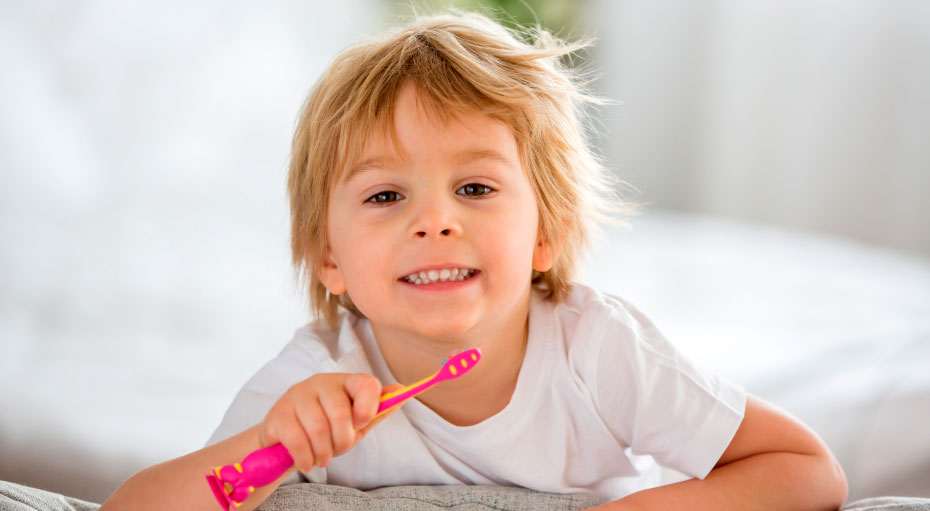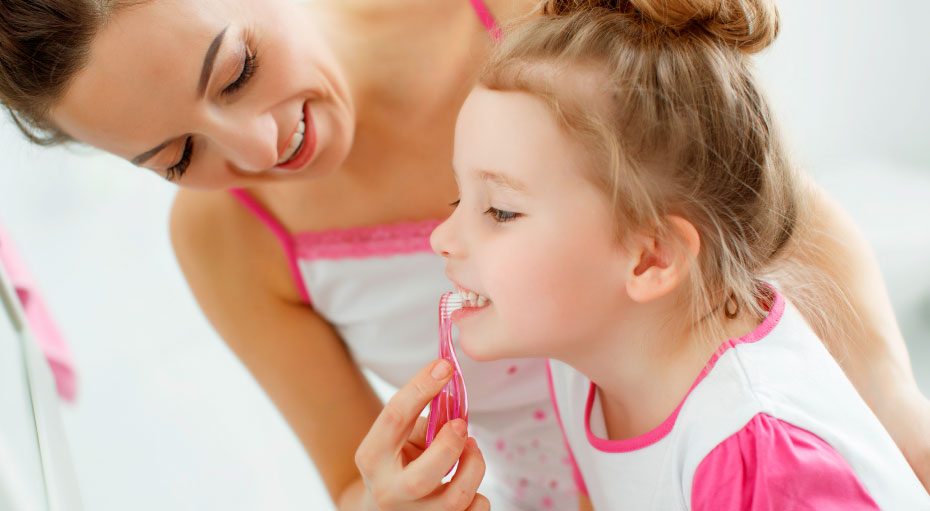5 Ways to Get Your Toddler Healthy Gums

Baby feeding and health care are two of the most vital components of good child care. Moreover, having scientifically based information is essential to avoid confusion about feeding and its potential affection on a toddler’s health.
In other words, parents must be aware of the nutritional facts of foods and the best practices for feeding a baby in order to avoid the development of oral health issues like periodontal disease in children.
Factually, according to the National Institute of Dental and Craniofacial Research, approximately 30% of children in the U.S. suffer from tooth decay. Moreover, in order to prevent this and other dental health issues in infants, we encourage parents to take their children to their first dental visit no later than 12 months of age.
More strictly talking, a study revealed that approximately 50% of kids under 3.5 years have their first contact with a dentist in the emergency room due to a cavity. So, this is a call to parents to effectively address their children’s oral health and contribute to their optimal growth.
But what are the consequences of poor oral care in an infant? The American Academy of Pediatric Dentists summarizes a list of impairments caused by tooth decay:
- eating;
- speaking;
- cognitive and;
- behavioral.
Check this article’s guidelines for information about properly caring for your little toddler’s oral health with some effective ways to get healthy teeth and gums.
Consider a Revision to Your Infant’s Feeding Habits
The World Health Organization – WHO reports that breastfeeding a baby has a tremendous impact on the infant’s growth, lowers the possibilities of cognitive underdevelopment, and lessens the appearance of some forms of cancer and chronic pathologies like obesity, diabetes, cardiovascular disease, and hypertension.
Moreover, no association exists between breastfeeding and dental caries until the first 12 months of age. Pediatric and dental associations recommend extending breastfeeding until the kid has 24 months.
Nonetheless, between months 12 to 24, researchers recommend mothers revise their eating habits and nutrition, as well as the feeding habits of the infant, considering the following guidelines:
- night feeding;
- number of meals per day and;
- sugar consumption.
These three considerations have a high impact on the development of tooth decay and gum disease in toddlers. Increased concerns arise from the baby feeding with a bottle. Specifically, we revise the dangers of nighttime baby bottles and the development of tooth decay and gum disease.
Nutrition and Sugar Consumption
An additional note, milk is fundamental for kids’ development. Milk is a source of essential vitamins and minerals:
Helps in the formation of epithelial, bonny tissue, teeth, and eye retinol.
Helps in the normal function of nerve cells, blood formation, and DNA synthesis.
Serves to strengthen the bones and teeth
It is a key component of bone and teeth.
Milk is critical for enamel conservation. However, milk also contains sugar. Parents must avoid the last bottle of milk before bedtime.
Bacteria metabolize milk sugar transforming it into acidic matter that erodes enamel. Yet a little kid needs milk; parents must create a habit of cleaning the toddler’s teeth and gums. But why is the last bottle of milk unsafe for your kid?
Avoid That Last Nighttime Baby Bottle
During the day, parents can and should clean up the baby’s gums and their baby teeth after feeding them. However, that last bottle of milk catches your little one tired and sleepy, so you won’t be able to take care of that last oral hygiene.
The longest milk residues stay in the mouth; there is a higher risk of bacteria metabolizing these milk residues, and this creates the perfect habitat for bacteria to permeate the enamel layer of teeth and to grow in the gums.
Baby Bottle Recommendations To Avoid Tooth Decay and Periodontal Disease.
Despite that the last bottle of milk seems to be the most unsafe, it is not the only reason that could cause early childhood caries and gum disease in a toddler. There are multiple factors that could progress into an oral health issue.
Also, there are some good pieces of advice you can implement to prevent your kid from developing tooth decay and gum disease from that last bottle of milk, as follows:
- Sanitize all the baby bottle utensils;
- Do not leave the bottle in your baby’s mouth;
- Do not leave your baby at the crib or bed with a bottle and;
- Replace milk with water.
Oral Hygiene Recommendations According To Your Kids Age
Under 12 Months
If your baby is under 12 months, clean your gums with a lightly damp cloth.
Between 12 and 24 Months
After the first 12 months and 24 months, use a soft-bristled brush and very little toothpaste as your kid could swallow it. Little by little, teach your kid how to brush and floss on its own.
After 24 Months
After the second year, your kid would have had to leave the bottle and eat different solid foods. Also, your little one must be able to grab the toothbrush and practice oral hygiene. Keep an eye on checking out its improvements, and expect to have to assist your kid several times, especially with flossing.

Using a Pacifier: How Good, How Bad Is It?
Here we regard the use of a pacifier, but first, we must mention thumb sucking, which is a natural reflex humans have from the womb. Moreover, thumb and pacifier sucking helps a baby feel safe and calm.
It is ok for parents to let their kids self-soothe and also use a pacifier. We must also admit that having a baby is demanding, and sometimes giving them a pacifier helps them have a break. But this habit should not extend any longer after the second year of age.
Here we include some dental considerations about pacifier use that you might want to include in your little kids’ dental checklist:
Sanitize Your Infants Pacifier at All Times
A pacifier catches germs and bacteria, so you must sanitize it every single time before your toddler gets it in its mouth. So, check these quick tips:
Profound Clean Up
Insert the pacifier into a bowl with boiled water for a couple of minutes.
Flash Clean Up
Get the pacifier into a warm flush of water.
Things To Avoid
Avoid using a fabric or a cloth to clean it, and refrain from dipping the pacifier into a sweet or candy.
Stop Pacifier Use After Year Two
Pacifier usage and thumb-sucking lead to orthodontic complications in the future. Indeed, parents must get knowledgeable about mechanisms to avoid pacifier use after year 2 in order to prevent any of the following potentially occurring malocclusion cases.
- Open Bite
- Protruding upper front teeth;
- Tipped back lower teeth and;
- Crossbite
The Most Critical Consideration: Preventing Gums Disease in Your Kid.
Now, we’ve arrived at the most critical consideration of all, defining gum disease and listing its symptoms. Let’s check them out:
Periodontal Disease (Gums Disease): What Is It Exactly?
Harmful bacteria that accumulate on teeth and metabolize sugars produce an acidic film that serves as a reproductive environment for bacteria colonies and solidifies into a sticky matter that sits on the gum’s borderline.
Poor oral hygiene leads bacteria to reach the gums in an early gums disease stage named Gingivitis. At this point, your kid might experience the following symptoms:
- Red Gums;
- Inflammation;
- Soreness and;
- Mild bleeding.
Gingivitis is easily treatable. A pediatric dentist often recommends following a strict but easy-to-follow oral hygiene routine that includes brushing and flossing after meals and scheduling dental visits. Please remember only a dental specialist can determine if your kid suffers from gingivitis.
Tooth decay and gum disease spread quicker in a kid than in an adult, so we recommend parents take immediate action at the first sign of gum issues. Also, gum diseases often cause no pain and might pass undetected.
Concerns also increase as the infection attacks the periodontal ligaments and the bonny tissue affecting the supporting structure of teeth, leaving them prone to destruction and teeth falling off. Periodontal disease symptoms include:
- Receding gums;
- Teeth spacing;
- Bad breath;
- Pus between tooth and;
- Possible change in bite alignment.
Furthermore, periodontal disease is quite aggressive and requires an acute approach to the problem, according to the level of damage. Here we include the actions according to the levels of damage:
Mild and Moderate Periodontal Disease
Your kid’s teeth root surface structure has been attacked and presents signs of damage. Treatment includes the removal of tartar below the gums and a profound cleanup using a technique named scaling and root planing and a prescription of antibiotics.
Severe Periodontal Disease
Advanced stages of the periodontal disease require a more invasive approach that could derive in surgery to clean the infected areas under the gums and reshape the soft periodontal and hard bony tissue.
Early Preventive Care Improves Your Kids Quality of Life, Now and for Its Future

Experts say there is no better legacy you can leave your kid than education. But education goes hand in hand with excellent nutrition and providing a healthy environment for your kiddo. Oral and dental health has a meaningful and potent impact on your kid’s integrality of quality of life, so don’t lose the chance to make a huge impact on your kid’s esteem for the future; he or she will profoundly thank you.
At Kids Healthy Teeth, we are to advise parents and secure your child’s teeth preserves for the years to come. Bring your little one today, Schedule an appointment at Kids Healthy Teeth for a fun teeth-caring experience for your kid.
